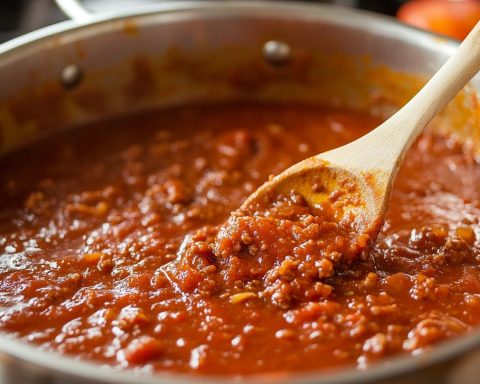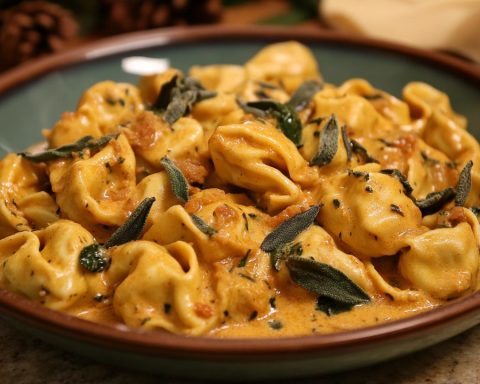Embark on a culinary journey to the vast steppes of Central Asia with Uzbekistanski Pilav, a traditional masterpiece celebrated for its rich, aromatic embrace. Often served during festive gatherings and family reunions, this one-pot marvel is a comforting embrace that binds communities through the warmth of hospitality and shared food. Rooted in the ancient traditions of Uzbek cuisine, pilav was historically prepared by nomadic tribes, each presenting its unique twist influenced by the bounty of local spices and produce. Imagine tender morsels of succulent lamb enveloped in radiant grains of rice, imbued with the golden allure of saffron, and mingling with the earthy sweetness of caramelized carrots and onions. Every bite reveals a delightful explosion of textures and flavors, making Uzbekistanski Pilav an unforgettable dish perfect for creating warm memories and stories that last a lifetime.
Ingredients
– 300g lamb, cut into bite-sized pieces
– 2 cups long-grain rice, preferably basmati or jasmine
– 1/2 cup vegetable oil
– 2 large carrots, julienned
– 2 large onions, thinly sliced
– 4 cloves garlic, whole, with skins on
– 1 tablespoon cumin seeds
– 1 teaspoon coriander seeds
– 1 teaspoon black peppercorns
– 2 bay leaves
– A pinch of saffron threads, soaked in 2 tablespoons warm water
– Salt to taste
– Water as needed
Instructions
1. Prepare the Rice: Rinse the rice under cold water until the water runs clear. Soak it in a bowl of water for about 30 minutes to ensure the perfect fluffy texture.
2. Cook the Lamb: In a large, heavy-bottomed pot or a traditional kazan, heat the vegetable oil over medium-high heat. Add the lamb pieces and sear until golden brown on all sides. Remove the lamb and set it aside.
3. Caramelize the Vegetables: In the same pot, lower the heat slightly and add the onions. Cook for 5-7 minutes until they turn a deep golden brown. Add the carrots and continue cooking until they soften, about 5 minutes.
4. Create the Spice Base: Stir in the cumin, coriander, black peppercorns, and bay leaves. Cook for an additional 2 minutes or until the spices are fragrant, filling your kitchen with their aromatic warmth.
5. Combine Ingredients: Return the lamb to the pot, along with salt to taste. Embed the whole garlic cloves into the mixture, distributing them evenly.
6. Layer the Rice: Drain the soaked rice and gently spread it over the meat and vegetable mixture. Do not stir. Add enough water to cover the rice by 1 inch.
7. Simmer and Infuse: Bring the pot to a boil over medium-high heat. Reduce to a low simmer and cook, uncovered, until the water mostly evaporates and holes form on the rice surface, approximately 15-20 minutes.
8. Steam the Pilav: Drizzle the saffron-infused water over the top. Cover the pot tightly with a lid or foil, reducing the heat to the lowest setting. Let it steam for 15-20 minutes.
9. Fluff and Serve: Once cooked, gently fluff the pilav with a fork. Discard the bay leaves and serve hot, letting the colorful beauty of the dish speak for itself.
Cooking Tips
– Savor the Spice: Toasting spices before use unlocks their full flavor potential, imparting a deeper, more nuanced aroma to your pilav.
– Saffron Essentials: A little saffron goes a long way; just a pinch will impart that distinctive, luxurious flavor and hue.
Serving Suggestions
Pair Uzbekistanski Pilav with a crisp, green salad or a side of yogurt infused with chopped fresh herbs like cilantro and mint. For a true cultural experience, enjoy it with a refreshing glass of tarragon tea or a well-aged red wine that complements the rich flavors of the lamb. Whether gathered around a bustling dinner table or amidst quiet moments of reflection, each serving of this dish is a tribute to family, friendship, and the timeless joy of coming together to share good food.
Unveiling the Secret Flavors of Uzbek Pilav: Beyond the Traditional Recipe
As celebrated as Uzbekistan’s hallmark dish, pilav—or plov—there are hidden secrets to its colorful culinary tapestry leaving food enthusiasts curious for more. What more does this delectably aromatic dish have to whisper beyond its traditional saffron-spiced story?
A Surprising Sweet Twist: While most recipes highlight the earthiness of carrots, some Uzbek chefs bake in apricots or raisins, crafting a subtle yet enchanting sweetness in every bite. Curiously, a twist of sweetness might seem unusual, but it plays a crucial role in creating a delightful harmony of flavors.
Choice Cut Debate: The ideal cut of lamb creates its profile in savory debates. Is it the lamb shoulder or leg that renders the perfected melt-in-your-mouth tenderness? Enthusiasts find themselves in a tug-of-war over preference, each ensuring their rendition of pilav embodies an exquisite richness.
Vegetarian Controversy: This largely meat-centric dish finds itself amidst modern dietary evolutions. Can it remain true to its origins without lamb? Adventurous cooks try eggplants or a mushroom medley as lavish alternatives, answering calls for a vegetarian adaptation.
Global Influence: Uzbek pilav meets kindred spirits in dishes from neighboring lands. Both Indian Biryani and Persian Polow share similar roots, each shaped by trade era exchanges, yet each preserving an authentic culinary identity of its own.
For those longing to explore the full breadth of Central Asian gastronomy, don’t hesitate to dive deeper at Saveur or Serious Eats. These journeys will unearth traditions lying beneath centuries-old recipes, inviting new interpretations to the table. Bon appétit!








